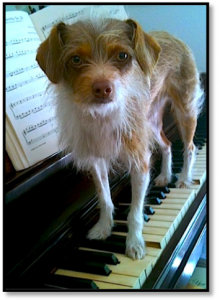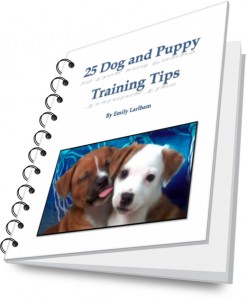by Emily Larlham
 ‘Think of your dog’s repertoire of behaviors as keys on a piano. To
‘Think of your dog’s repertoire of behaviors as keys on a piano. To
create variety you will need to play songs of different length,
tempo, and tune. Never play the same song repetitively. Never play all the notes just because they are there!’
In my opinion, the biggest key to success in training is creating variety in the way you interact with and train your dog. The more variable and unpredictable you make your training plans the more successful you will be, achieving faster and more reliable results. Variety also increases your dog’s interest to learn and play our strange human games.
Here are some different ways you can add variety to your training sessions:
Reinforcement: You can vary what your dog receives as reinforcement during training. You can choose to reinforce your dog with different kinds of food, toys or any other reinforcers your dog enjoys (such as playing, catching water from the hose, getting to sniff a bush, or greeting other dogs and people).
When training new behaviors it’s best to use the reinforcement your dog is the most accustomed to, so your dog doesn’t get disappointed and frustrated when he doesn’t get the reward he was expecting. For example, if your dog likes food more than anything else, use food when training new behaviors. However, once your dog is a highly skilled learner you can then add more variety when training new behaviors. With behaviors your dog already knows, you can vary what you give as the reward so your dog never knows what he might get.
You can also add variety by giving reinforcement on a variable ratio, meaning that your dog never knows WHEN he will get the treat. It is best to always give a reward after a correct behavior while your dog is still learning the behavior, but when the dog knows the behavior you can start to give the dog rewards on an average. For example, if you are working on an average of 5 behaviors for a treat, you will give your dog a treat after perhaps 2 correct behaviors, 4 behaviors, 3 behaviors, 7 behaviors, 5 behaviors, or 1 behavior. Your dog should never know when the reinforcement is going to happen. To sum up, by varying reinforcement when working on a behavior your dog already knows, he should not know WHAT he will get as a reward or WHEN he will get it!
Duration: You can vary the duration of your training sessions, so your dog never knows how long or short they will be. You can have extremely short sessions, longer sessions and sessions of a normal length.
Time of day: Train when your dog has the zoomies or when he is sleepy. Train before your dog has had exercise or after your dog has had exercise. Train before a meal or train after a meal. Train new and important behaviors when your dog is the most receptive and work on behaviors your dog does really well when training at times that your dog is less interested in training.
You can train when it’s warm, when it’s cold, during different times of the day and the night.
Location: Train your dog in different locations. If you have a dog that is fearful or over-excited when away from home, you can change location in the same training area at home. Simply by moving to a different part of the room you can create variety and renew interest in learning.
What you train: To create variety in a training session using what you train, you can work only on teaching new behaviors, maintaining existing behaviors, or adding criteria to old behaviors. You can also work on a combination of the two or the three in the same session. For example, in one training session you could teach your dog the new behavior of spinning, then maintaining the behavior of eye contact which needed brushing up, and adding criteria to your dog’s stay by getting further from your dog than you have in other sessions. Then in another training session, perhaps you simply work on one behavior- teaching your dog to leave food on the ground- and that is all you work on.
How you train: You can set up training sessions with your dog in which you will be using capturing (where you simply click a behavior your dog is already doing), free shaping (where you reinforce your dog for doing approximations of the final behavior you wish to achieve with no hints or targets) or luring (where you are using a treat lure or a target to get the initial behavior you wish to train) on their own or using combinations of them in the same training session.
Watch this video for more information on capturing, free shaping and luring:
Energy level: You can create variety by working on calm behaviors and working on excitable behaviors separately in training sessions, as well as back to back in the same lesson.
Create combinations: Combine all the different ways of adding variety in different combinations in your training sessions. As you can see, the combinations are endless!
NEVER get into the habit of drilling your dog on all the behaviors he knows each day or each time you train your dog. That is a boring and predictable way to train.
Tip: To make sure you are adding variety to training sessions, make sure to always be training new behaviors throughout your dog’s life, even if you don’t finish them. This will keep your dog excited and interested in learning. Training tricks is a great way to add variety to training sessions without there being importance on how the final behavior will turn out, taking away the pressure of achieving training perfection all the time. You can also work on your own training skills by teaching new unimportant behaviors, rather than panicking that you are not getting exactly what you had hoped for. Even if we try not to show it, dogs can tell when we are disappointed.
Another tip: If you are stuck and can’t seem to think of a way to add variety to a training session, simply get a “prop” or object that your dog has not interacted with before and use it in the training session. The novelty of the new item will immediately add variety to your session. For example, turn a flowerpot up-side-down and teach your dog to put his two front feet on it.
 25 Dog and Puppy Training Tips:
25 Dog and Puppy Training Tips:
For each month of the year, I will release 2 training tips that will be accessible for free at dogmantics.com. If you simply cannot wait for the information to be published online, you can buy the collection of all 25 training tips in an ebook format here: 25 Dog and Puppy Training Tips
This is a list of all the tips included in the ebook, and that will be eventually available online:
- Teaching a dog previously kept outside to be calm inside the house
- The problem with ignoring unwanted behaviors
- Fading a lure
- Adding a verbal cue or changing a cue
- Dogs and babies
- Socializing tips- Our world can be a scary place!
- What to do if your puppy bites you OUTSIDE of a training session
- Changing your thinking from “I don’t like” to “I need to work on”
- What to use as reinforcement
- Treat deliveries
- Teaching your puppy appropriate greetings on leash
- Teaching “All done” for training sessions and dinnertime manners
- Variety is the spice of life… and training!
- Teaching your puppy to walk off leash
- Don’t let your dog free feed
- Don’t only work on one behavior at a time
- Separation training tips
- Monkey see, monkey do- Take advantage of social facilitation
- Always remember to release your dog!
- The importance of handling
- Chewing
- Teaching “Drop” and “Get it”
- What to do if your puppy sits and refuses to budge on a walk
- Generalizing
- Training your dog to do absolutely… NOTHING!
